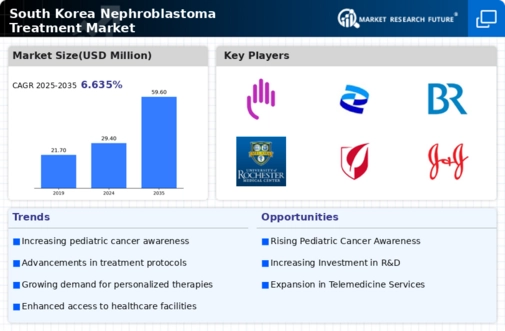Increased Awareness and Education
Increased awareness and education regarding nephroblastoma are driving growth in the treatment market. Various organizations and healthcare providers in South Korea are actively engaging in educational campaigns aimed at parents and healthcare professionals. These initiatives focus on the signs and symptoms of nephroblastoma, emphasizing the importance of early detection and timely intervention. As awareness grows, more families are likely to seek medical advice, leading to earlier diagnoses and improved treatment outcomes. This heightened awareness is expected to translate into a greater demand for treatment options, thereby positively impacting the nephroblastoma treatment market. Furthermore, educational programs for healthcare professionals ensure that they are equipped with the latest knowledge and skills to manage nephroblastoma effectively, further enhancing the overall treatment landscape.
Government Initiatives and Funding
Government initiatives aimed at improving pediatric cancer care are significantly impacting the nephroblastoma treatment market. In South Korea, the government has allocated substantial funding to enhance cancer research and treatment facilities, with a focus on childhood cancers. For instance, recent budgets have earmarked over $50 million for pediatric oncology research, which includes nephroblastoma. These initiatives not only facilitate the development of new treatment protocols but also ensure that existing therapies are accessible to patients. Additionally, public health campaigns aimed at raising awareness about childhood cancers are likely to lead to earlier diagnoses and improved treatment outcomes. As a result, the nephroblastoma treatment market is poised for growth, driven by increased government support and funding for innovative research and treatment options.
Rising Incidence of Nephroblastoma
The nephroblastoma treatment market is experiencing growth due to the rising incidence of nephroblastoma in South Korea. Recent data indicates that the annual incidence rate of this pediatric cancer is approximately 1.5 cases per 100,000 children. This increase in cases necessitates the development and availability of effective treatment options, thereby driving market demand. As healthcare providers and institutions recognize the need for specialized care, investments in research and treatment facilities are likely to rise. Furthermore, the growing awareness among parents and healthcare professionals about the symptoms and early detection of nephroblastoma contributes to earlier diagnosis and treatment, which is crucial for improving patient outcomes. This trend suggests a sustained demand for innovative therapies and supportive care within the nephroblastoma treatment market, ultimately benefiting patients and healthcare systems alike.
Technological Advancements in Treatment
Technological advancements in medical treatments are playing a pivotal role in shaping the nephroblastoma treatment market. Innovations such as targeted therapies and immunotherapy are becoming increasingly prevalent in the treatment landscape. For instance, the introduction of novel agents that specifically target cancer cells has shown promising results in clinical trials, potentially improving survival rates. Moreover, advancements in imaging technologies allow for better diagnosis and monitoring of nephroblastoma, which is crucial for tailoring treatment plans. The integration of artificial intelligence in treatment planning and patient management is also emerging, suggesting a future where personalized medicine becomes the norm. These technological developments are likely to enhance the efficacy of treatments available in the nephroblastoma treatment market, ultimately benefiting patients and healthcare providers.
Collaboration Between Research Institutions
Collaboration between research institutions and healthcare providers is emerging as a key driver in the nephroblastoma treatment market. Partnerships aimed at conducting clinical trials and research studies are becoming more common, facilitating the sharing of knowledge and resources. In South Korea, several leading hospitals and research centers are joining forces to explore new treatment modalities and improve existing protocols. This collaborative approach not only accelerates the pace of research but also enhances the quality of care provided to patients. By pooling expertise and resources, these collaborations are likely to lead to breakthroughs in treatment options, ultimately benefiting the nephroblastoma treatment market. As more institutions recognize the value of collaboration, the landscape of pediatric oncology is expected to evolve, fostering innovation and improving patient outcomes.

















Leave a Comment